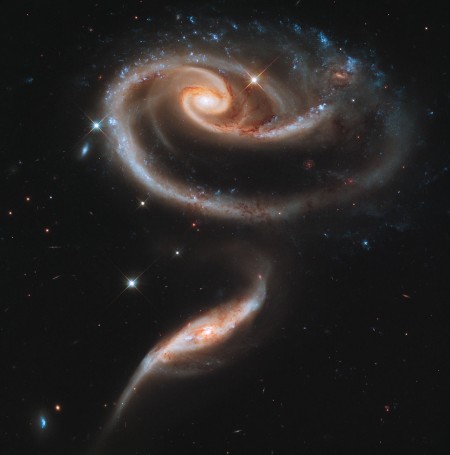Hubble Celebrates 21st Birthday With Colliding Galaxies Sexiness.
Enlarge. | Via.
It’s okay to get a little sexy on your 21st birthday! It’s one of the last times that you can get hammered, make some bad decisions, and use a birthday to support the claim. So in order to celebrate Hubble’s birthday which turns 21 years-old on April 24, astronomers have released this sexy image of two colliding galaxies.
Bad Astronomy:
Most spiral galaxies are pretty close to being symmetric and circular, but UGC 1810 is offset and weird. That one arm is thick and sweeps out much farther than the others, making the nucleus of the galaxy decidedly off-center. The string of blue clumps on the top of the galaxy is a sign of furious star formation; massive, hot, blue stars are the culprit, and don’t live long, meaning they were born relatively recently. UGC 1813 is distorted as well, with its arms twisted oddly and gas flung every which-way.
These two galaxies probably passed very close to each other in the past few million years. The gravity of each galaxy distorted the other, drawing the arms out, slamming gas clouds into each other. Also, the nuclei of both galaxies are unusual: the smaller galaxy’s core is very luminous in the infrared, indicating strong star formation obscured by dust, and the bigger galaxy’s core is giving off light indicating copious amounts of ionized gas. This is another sign of collision. The gravitational disturbance of this cosmic train wreck has funneled gas into the cores of both galaxies; in the case of the smaller one it has triggered a burst of star formation, and in the bigger one the gas has flowed around the massive black hole at its core, heating up and giving off light (although recent observations of other galaxies have cast some doubt on this idea of collision-fed black holes).
While both galaxies are distorted, they still have retained their overall spiral/disk shapes, which indicates this is still early on in their cosmic dance. If they’re bound to each other gravitationally the interactions will continue, and most likely will end with the two galaxies merging to become one larger galaxy. It’s a common occurrence in the Universe, and our own galaxy may have grown to its large size this way too.
Outstanding. There’s something fucking colossal about two galaxies smashing into one another. A scope beyond my fat simian brain. I’d love to be able to watch it in some sort of time-lapse, the two fusing into one. Bananas.




